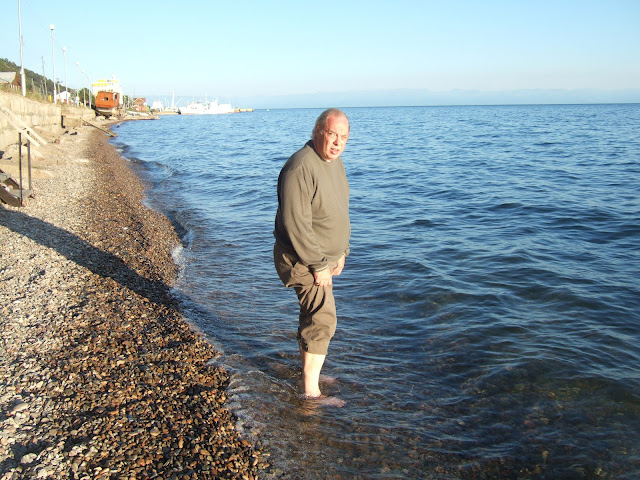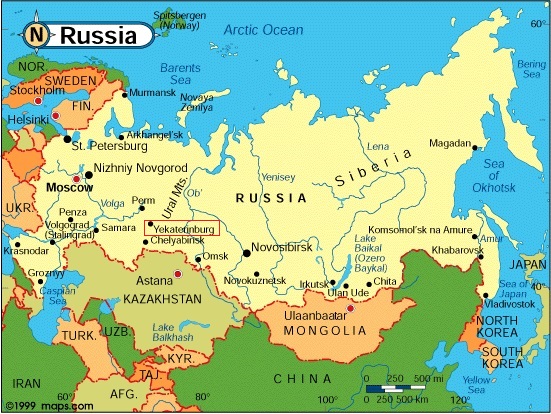A Couple of Days Beside the World's Oldest and Deepest Lake
Arriving in Irkutsk
 |
| Russia |
 |
| Listvyanka is a little north of Irkutsk on the south west shore of Lake Baikal |
Lake Baikal
We drove through the city and across the Angara River, which flows from the southern end of Lake Baikal and eventually feeds into the Yenesei. Then we travelled through birch forest - as though we had not seen enough already – before finally arriving at the lake shore.
 |
| Looking across Lake Baikal |
Formed 50 million years ago in a rift between two tectonic plates, Baikal is the world’s oldest lake. 636 km long and up to 80 km wide, it is the fifth largest in area but at over 1600m by far the deepest. It also has the greatest volume of water of any lake - more than the North American Great Lakes combined – containing a staggering 20% of the world’s non-frozen fresh water. It is certainly the hugest slab of flat, clear, cold water that I am ever likely to see.
Listvyanka
Listvyanka is a village of wooden houses lying beside the main road. We bumped through the rutted streets and turned into the yard of a typical foursquare single story house. Galina, who was to be our landlady for the next three days introduced herself and led us to the dining room where a substantial breakfast had been laid out. We had eaten some bread and cheese on the train, but Galina’s pikelets were particularly moreish and we did full justice to her efforts.
 |
| Galina's House, Listvyanka |
Galina was a widow living alone except for her paying guests and a grandson who was delivered in the morning and taken away in the evening - and spent the intervening time watching cartoons on the television. As is typical in Siberia, the core of the house consisted of four large comfortable rooms built round a central boiler. In summer, the boiler was not in use, but we could imagine how necessary it must be in the long Siberian winter. The house had mains electricity and UPVC double-glazing hiding behind the carved wooden exterior but despite being two hundred metres from the world’s biggest fresh water supply - a supply so pure it is bottled for drinking - it had no running water; a couple of aluminium barrels being delivered daily along with her grandson. A pit toilet stood outside the back door, and each washbasin was equipped with a small tank that she filled every morning. Feeling a little sticky after two and a half nights on a train we were please to learn that Galina also had the Siberian version of a sauna. The remainder of the grounds was given over to a lush kitchen garden featuring a huge patch of dill - no Siberian meal is complete without a liberal sprinkling of dill fronds.
Lystvyanka Church
After breakfast, we visited the little wooden church built on a hill at the back on the village. Dating from the 18th century it is the oldest building in the area – wooden villages are prone to fires so old buildings are a rarity. It was moved lock, stick and icon from its original site to make way for the tarmac road. A christening was in full swing, several families having brought their infants who were being baptised in quick succession. Lydia seemed oblivious as she walked around pointing out various items of interest. Feeling uncomfortable, we dragged her outside and left the priest to water his flock in peace.
 |
| Listvyanka Church |
Lake Baikal Museum and Freshwater Seals
We walked back to the tarmac road and up to the small Lake Baikal museum. It had a comprehensive explanation of the particular geological conditions that formed the lake and a self-congratulatory rundown on its size compared with every other major world lake. Eighty-five species of plants and animals live here and nowhere else, including the omul, a trout-sized member of the salmon family which finds its way, smoked or fresh, into most local markets. They featured in the aquarium along with several other fish and a small family of Baikal seals, the world’s only exclusively fresh water seal. Small, black-furred balls of lard, they hurtled around their tank like giant jet-propelled tadpoles. If that was the tadpole, I would not want to meet the frog.
Lydia returned to Irkutsk and we strolled back to Galina’s for a lunch of huge fish cakes – a lake fish, apparently but not omul. In the afternoon we needed to sleep off lunch before taking a stroll through the village streets. We admired the carved and painted woodwork which surrounds most doors and windows - a style of decoration known as ‘Siberian Lace’. The houses were well kept, the carving freshly painted, but there were surprisingly few people around. The sun shone, but the nip in the breeze was sufficient to remind us where we were.
 |
| House, Listvyanka village |
Siberian Sauna
At six o’clock Galina announced that she had fired up the sauna. Unlike the regular version, the Siberian sauna comes with a tank of hot water, a churn of cold and a washing-up bowl to mix them in. There are also gaps in the wooden floor to let the excess water drain away. It was a joy to have a proper wash and to become completely and very satisfyingly clean.
 |
| Galina's sauna, Listvyanka |
Feeling deeply relaxed we faced up to dinner which was, fortunately, less heavy; potato dumplings, cabbage and sour cream, along with the inevitable cucumbers and tomato, covered with a layer of dill the thickness of a light carpet. In the evening we strolled by the lake.
A Paddle in Lake Baikal
Being such a huge body of water, the temperature varies little throughout the year. It is the last open water to freeze in the winter, and warms up hardly at all in the summer. Most of the year the water is around 4º C. I took off my shoes, rolled up my trousers and bravely waded in – as far as my ankles. Dipping your hand in the lake is supposed to add a year to your life, submerging your feet adds 5, while immersing your whole body adds 25. I settled for five, and at the cost of some pain. Several men were actually swimming. Overweight, middle-aged men (the salt of the earth, in my not entirely unbiased opinion) egged each other on and slurped vodka to build up their courage. They did not look entirely comfortable, but I admired their bravery – and, of course, they will live for ever, if they don’t die in the attempt.
 |
| Adding years to my life, Lake Baikal |
Although the church and residential buildings are all wooden, more permanent structures line the main road. Listvyanka clearly sees itself as a lakeside resort in the making, but by nine thirty everything was closing down and there was little more to do than wander back to Galina’s for a read and a nightcap. Being in Russia I was attempting to read ‘Crime and Punishment’ but several hundred pages in with several hundred more to go I was finding it hard work.
A 'Softies Trek' by Lake Baikal
Next day, Sacha came to guide us on a day’s walk. This was billed as a ‘softies trek’ but he set off along the lakeside road like it was a route march. At the end of the road we started to climb. Slowly but steadily, we rose through the birch and pine forest and across clearings carpeted with wild flowers to a ridge 800m above sea level and 150m above the lake. Listvyanka is the end of road, but we passed several groups of young men and some families who had carried tents and equipment a mile or more before setting up their weekend campsites.
 |
| Following Sacha up the ridge |
Sacha told us he too was once a Maths teacher. ‘The Soviet times were the best’ he said. ‘When they ended I worked for three months and never got paid.’ He gave up teaching and became a mountain guide. He does not earn much, he said, but he likes being out in the fresh air. When we came to a clearing full of purple clover Sacha pulled a bag from his rucksack and began collecting the flowers. We helped him, though not entirely sure why he was doing it. ‘It’s for my mother,’ he explained, ‘she soaks the flowers in vodka. A daily glass of clover-flavoured vodka is better medicine than you can get from any doctor.’
Lunch by Lake Baikal
After an hour or so walking along the ridge we descended to the lakeside at a small stony beach. Sacha extracted a saw and an axe from his capacious rucksack and gathered up the wood for a fire. Then he produced a substantial billycan, strode unflinchingly into the lake and collected some water. As the water boiled he delved into his pack again to produce a red checked table cloth, dishes, spoons, cups, some bread, cheese, salami, frankfurters, peppers, cucumbers, biscuits and chocolate. He made tea from some of the boiled lake water and poured instant mashed potato into the rest. We sat in the sunshine by the lake and ate sausage and instant mashed potato made from the water of Lake Baikal – as fine a combination of the exotic and the banal as can be enjoyed anywhere.
 |
| Sacha makes a fire on the beach, Lake Baikal |
Walking back on a lower level path we crossed the top of several lakeside cliffs. Lynne survived an attempt to throw herself over a precipice, and although Sacha seemed momentarily alarmed by the prospect of one of his clients plummeting to their death, I don’t think she was in quite as much danger as she would like to make out ('Yes I was'Lynne).
 |
| Across several lakeside cliffs, Lake Bailkal |
It was a long trudge back to the village, but that did nothing to spoil what had been a beautiful day out. Sacha caught his bus back to Irkutsk and we reached Galina’s just after six to find we were no longer her only lodgers. Naomi and James were gap year students planning to take up university places in September. They had been in Australia and were now travelling home overland. They spoke of their adventures with infectious enthusiasm and as they were taking the same journey as us, but in the opposite direction, we exchanged information about what was to come. Given Listvyanka’s preternatural quietness, it was good to have somebody else to talk to, though they made me feel so old – less than a year before I could have been their teacher. It was not their fault, the problem was entirely in my head, but knowing that made it no better.
After a relaxing sauna and a good night’s sleep the right hand drive minibus came to take all four of us back to Irkutsk.
Part 1: Moscow
Part 2: Yekaterinburg
Part 3: Across Siberia to Irkutsk
Part 4: Listvyanka and Lake Baikal
Part 5: Irkutsk
Part 6: Ulan Ude (1)
Part 7: Ulan Ude (2)
Part 8: To Naushki and into Mongolia
Part 9: Across the Mongolian Steppe from Ulan Bator to Burd Sum
Part 10: With the Mongolian Nomads
Part 11: Ulan Bator
























